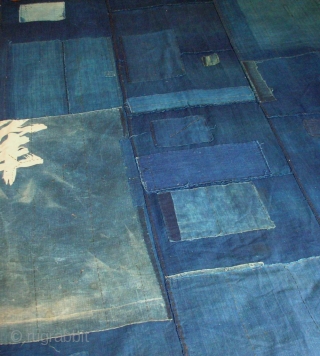Back
Boro futon cover, Japan, Taisho (circa 1920), cm 165x102. There is a class of Japanese folk textiles known as boro, which literally translated means "rags" or "ragged." Broadly speaking, boro textiles are the patched, mended and heavily stitched indigo-dyed cotton cloths whose history extends back to the nineteenth century and continues on through the early-to-mid twentieth century, and to fully appreciate they apart from their obvious artistic appeal, one has to delve into their history by understanding something of cotton's cultural significance in Japan. As a matter of fact, however, boro textiles prove to be an aesthetically valuable art form, that mostly appeal to collectors of Contemporary Art, as well as to collectors of Tribal and Outsider Art. As reported in the excellent article by Stephen Szczepanek, ‘Rags to Riches’ published on hali 158, some collectors eschew buying flashier examples composed of multiple pattern and stripes, focusing instead on boro textiles predominantly made of grades of blue. a sort of ‘purist’ approach to the subject where, of course, the quality of indigo dyeing is paramount. What we have here is such an example, made up recycling used fabrics with different shades of lovely indigos. An unintended artist’s touch was the inclusion of a large fragment showing part of a kanji character. Quite difficult to photograph (at least for my own skills), i have taken also ‘loose’ details in the morning light to further enhance differences among various shades. Apart from a tiny hole, the cloth is in very good condition. Rigorous in its look, yet with a clear ‘mad’ side downing… just great.
price:
SOLD
- Home
- Antique Rugs by Region
- Category
- Profiles
- Post Items Free
- Albums
- Benaki Museum of Islamic Art
- Budapest: Ottoman Carpets
- Gulbenkian Museum
- Islamic Carpets. Brooklyn
- Islamic Textiles. Brooklyn
- Konya Museum: Rugs
- MKG, Hamburg
- MMA: Caucasian Carpets
- MMA: Mamluk Carpets
- MMA: Mughal Indian Carpets
- MMA: Ottoman Carpets
- MMA: Safavid Persian Carpets
- MMA: Turkmen Rugs
- McCoy Jones Kilims
- Ottoman textiles. Met
- Philadelphia Museum
- Rugs and Carpets: Berlin
- Seljuqs at the Met
- TIEM, Istanbul: Carpets
- V&A: Classical Carpets
- Vakiflar Carpets: Istanbul
- Baluch Rugs: Indianapolis
- Gallery Exhibitions
- Jaf an Exhibition
- Alberto Levi Gallery
- Andean Textile
- Christie's London: 2016
- Francesca Galloway
- HALI at 40
- ICOC Washington, DC 2018
- Jajims of the Shahsavan
- London Islamic Week April, 2018
- Mongolian Felts
- Navajo Rugs: JB Moore
- Persian Piled Weavings
- SF Tribal & Textile Art Show 2020
- SF Tribal 2019
- Sotheby's: C. Alexander
- Turkish Prayer Rugs
- Turkmen Main Carpets ICOC 2007











